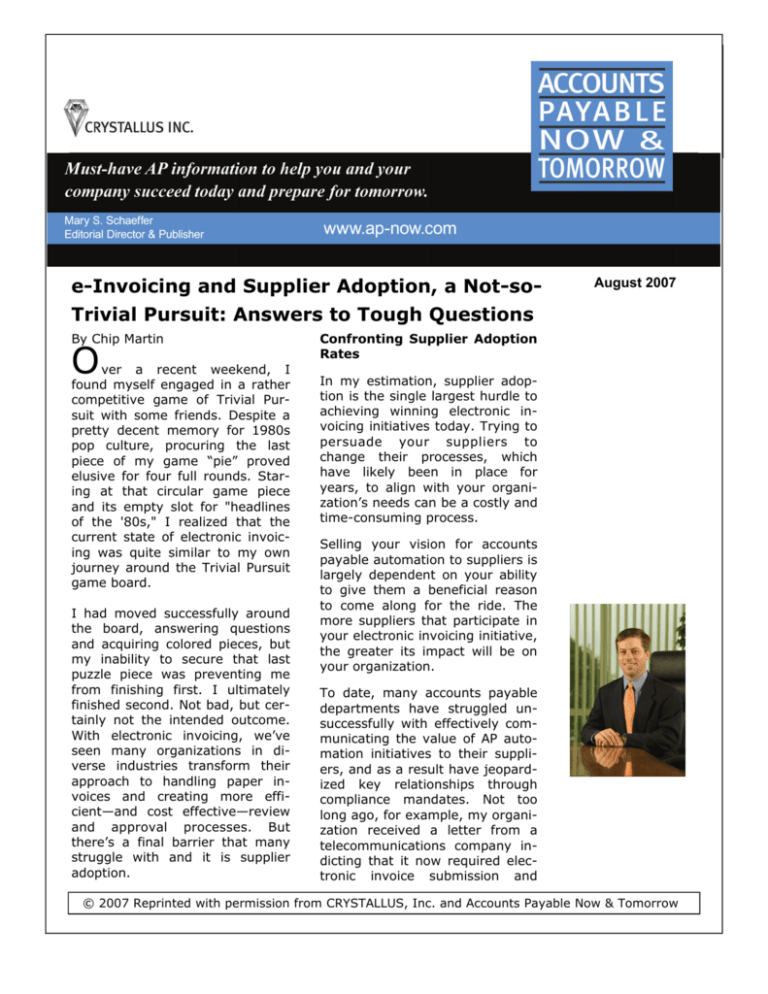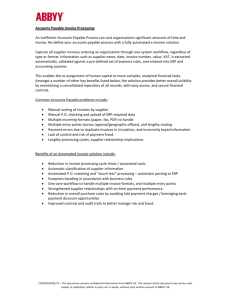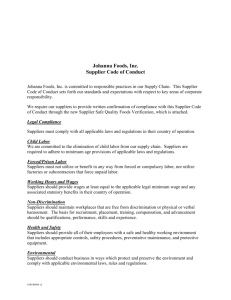
e-Invoicing and Supplier Adoption, a Not-so-
August 2007
Trivial Pursuit: Answers to Tough Questions
By Chip Martin
O
ver a recent weekend, I
found myself engaged in a rather
competitive game of Trivial Pursuit with some friends. Despite a
pretty decent memory for 1980s
pop culture, procuring the last
piece of my game “pie” proved
elusive for four full rounds. Staring at that circular game piece
and its empty slot for "headlines
of the '80s," I realized that the
current state of electronic invoicing was quite similar to my own
journey around the Trivial Pursuit
game board.
I had moved successfully around
the board, answering questions
and acquiring colored pieces, but
my inability to secure that last
puzzle piece was preventing me
from finishing first. I ultimately
finished second. Not bad, but certainly not the intended outcome.
With electronic invoicing, we’ve
seen many organizations in diverse industries transform their
approach to handling paper invoices and creating more efficient—and cost effective—review
and approval processes. But
there’s a final barrier that many
struggle with and it is supplier
adoption.
Confronting Supplier Adoption
Rates
In my estimation, supplier adoption is the single largest hurdle to
achieving winning electronic invoicing initiatives today. Trying to
persuade your suppliers to
change their processes, which
have likely been in place for
years, to align with your organization’s needs can be a costly and
time-consuming process.
Selling your vision for accounts
payable automation to suppliers is
largely dependent on your ability
to give them a beneficial reason
to come along for the ride. The
more suppliers that participate in
your electronic invoicing initiative,
the greater its impact will be on
your organization.
To date, many accounts payable
departments have struggled unsuccessfully with effectively communicating the value of AP automation initiatives to their suppliers, and as a result have jeopardized key relationships through
compliance mandates. Not too
long ago, for example, my organization received a letter from a
telecommunications company indicting that it now required electronic invoice submission and
© 2007 Reprinted with permission from CRYSTALLUS, Inc. and Accounts Payable Now & Tomorrow
Page 2
ACCOUNTS PAYABLE NOW & TOMORROW™
payment disbursement via their
ePayables Center, which was operated by a software company.
After briefly detailing the benefits
of this service, the letter went on
to disclose that failure to comply
with this request would allow the
telecommunications company to
dictate its own payment terms
and/or refuse to conduct any future business with our company.
For many suppliers,
this approach could hardly be described
as best practice in managing successful, long-term vendor relationships.
Understanding What
nates with Suppliers
Reso-
The foundation of a solid relationship between buyers and suppliers isn’t built on buying power
alone, it also incorporates cooperation, mutual respect, and a
shared commitment to quality.
From a supplier’s perspective,
throwing support behind your AP
automation initiative should represent an opportunity to improve
the efficiency of its own accounts
receivable (AR) processes.
To achieve this, buyers, or payers, must be proactive in providing opportunities for suppliers to
shorten the transaction cycle and
offer self-service access to information related to the status of
invoice approval and settlement
processes. Always remember that
at the end of the day, suppliers
want and need to control receivables with an ultimate goal of getting paid faster, or at best, on
time. Your role in helping them to
do this will play a significant role
in their loyalty.
If mandating participation or
trumpeting other incentives such
as the promise of reduced postage costs have stymied supplier
interest in your organization’s einvoicing initiative, what approaches can deliver the full
benefits of electronic invoicing
without putting your supplier relationships at risk?
New Thinking
Suppliers
for
Migrating
One potential approach to circumnavigating the supplier adoption
hurdle is to combine third-party
data capture services with a vendor segmentation strategy that
allows you to determine which
suppliers are ideal candidates for
submitting electronic invoices directly.
I mentioned earlier the difficulty
associated with trying to get suppliers to change long standing
processes. Through the use of a
third-party data capture service,
which converts paper invoices in
electronic data, you’re requesting
the supplier only accept minimal
Accounts Payable Now & Tomorrow (ISSN: 1557-3567) is published monthly for $349 per year by
CRYSTALLUS, Inc., 171 Haut-Brion Ave., Newark, DE 19702.© 2007 Crystallus Inc. All rights reserved. A
one-year subscription includes 12 monthly issues plus regular e-mail transmissions of news and updates.
Periodicals postage paid at Newark, DE and additional mailing offices. Reproduction without permission is
prohibited. Accounts Payable Now & Tomorrow does not render legal, accounting or other professional
services. Legal and other expert assistance should be sought from competent professionals.
AUGUST 2007
Page 2
process change, most likely sending invoices to a P.O. box as opposed to your office.
By pursuing an electronic invoicing initiative also capable of accommodating paper invoices,
you’re able to simultaneously
open the door for suppliers who
might not yet be ready (or willing)
to make the transition to electronic invoice submission. Over
time, you can gradually expose
them to the mutual benefits of
electronic invoicing (an opportunity to improve their own AR
processes) through self-service
online visibility into invoice receipt
and approval status, until they’ve
reached a point where they’re
ready to make the switch.
The other half of this approach to
supplier migration is vendor segmentation, or the process by
which you determine those suppliers ready and willing to make an
immediate jump to electronic invoicing. Breaking down your sup-
About Chip Martin and
Bottomline Technologies
Chip Martin serves as vice president of product management for Bottomline Technologies, and has domain
expertise in payment systems, middleware integration,
Web services infrastructure, and standards-based messaging protocols. He has a broad background within the
technology industry, with more than 10 years’ experience in sales, marketing and product management,
and five years of experience in software product management and marketing.
Information about Bottomline Technologies and its
products and services can be found at
www.bottomline.com/
plier base is an effective way to
get your initiative off the ground
because it allows you to build
your supplier network at a pace
best suited to the resources of
your accounting department.
All the while, those not yet submitting invoices electronically are
leveraging the third-party data
capture service, helping your organization to successfully achieve
the benefits of 100% electronic
invoicing without placing any supplier relationships in jeopardy.
Reaching New Heights
Through a pragmatic approach to
supplier migration, accounts payable departments can place themselves in a much stronger position
to capitalize on the full potential
of electronic invoicing. With more
suppliers on-board, the greater
your ability to work more collaboratively with suppliers to resolve
discrepancies and disputes, proactively negotiate early settlement
discounts, and bring your bank
into the mix to take advantage of
trade financing opportunities that
might be available.
While process efficiency gains and
cost reductions are important
benefits of electronic invoicing,
unlocking an initiative’s strategic
value is where the real promise
lies. But without the ability to obtain broad supplier support for
your initiative, you’ll be stuck like
I was trying to fulfill the winning
piece of the “pie.” AP N&T









